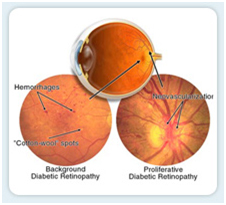Overview
Diabetes damages blood vessels in the rear of the eye. This condition is called diabetic retinopathy. It can lead to vision loss or blindness. You already may have diabetic retinopathy, or be at risk for it. But you can take steps to reduce your risk of vision loss from this condition.
In patients with diabetes, the body is unable to effectively make or process insulin, the hormone that regulates the level of sugar in the blood. Diabetes can interfere with the normal functioning of many parts of the body, including the eyes. Diabetic retinopathy is a common vision problem that affects diabetics.
Signs and Symptoms
The effect of diabetic retinopathy on vision varies widely, depending on the stage of the disease. Some common symptoms of the disease are listed below:- Blurred vision - often linked to blood sugar levels
- Floaters and flashes
- Sudden loss of vision
Though the symptoms listed above can signal diabetic retinopathy, diabetes can cause various other eye symptoms as well. If you are diabetic and experiencing any type of vision problem, you should seek treatment from a doctor immediately. Many diabetic retinopathy patients are examined by an internist or endocrinologist before they are referred to our retina specialists for treatment.
If you would like to be tested for diabetic retinopathy or are seeking treatment for the disease, contact our retina specialists to set up an appointment.
Pregnancy and diabetic retinopathy : - Pregnancy can make diabetic retinopathy worse. If you are thinking of having a baby, see your eye doctor right away. If possible, he or she should examine your eyes before you become pregnant as well as during your pregnancy. (especially during the first three months )

HOW IS DIABETIC RETINOPATHY DIAGNOSED?
A complete eye examination is required for the detection of diabetic retinopathy. We perform a painless examination of the retina of the eye using an instrument called the indirect ophthalmoscope after dilating the pupils. If diabetic retinopathy is found, a special test called fluorescein angiography may be performed where a dye is injected in the vein and photographs of the retina are taken.
Effect of Diabetes on the Retina
 People with diabetes have an increased chance of developing a variety of eye problems, including cataracts and glaucoma. However, the effect of diabetes on the retina is the most serious threat to vision. Typically, changes begin to take place in the retina after a patient has been living with diabetes for 10 to 15 years. The effect of diabetes on the retina and vitreous is called diabetic retinopathy.
People with diabetes have an increased chance of developing a variety of eye problems, including cataracts and glaucoma. However, the effect of diabetes on the retina is the most serious threat to vision. Typically, changes begin to take place in the retina after a patient has been living with diabetes for 10 to 15 years. The effect of diabetes on the retina and vitreous is called diabetic retinopathy. Over time, diabetes begins to affect the circulatory system of the retina. In the earliest phase of the disease, known as background diabetic retinopathy, the arteries in the retina become weakened and leak, forming small, dot-like hemorrhages. These leaking vessels often lead to swelling or edema in the retina, which may result in decreased vision.
The next stage is known as proliferative diabetic retinopathy. In this stage, circulation problems lead to oxygen-deprivation in some areas of the retina. New, fragile, blood vessels develop as the circulatory system attempts to maintain adequate oxygen levels within the retina. This is called neovascularization. The delicate vessels hemorrhage easily and blood may leak into the retina and vitreous, causing spots or floaters, and an overall decrease in vision.
As the disease progresses even further, continued abnormal vessel growth and scarring can result in serious problems such as retinal detachment and glaucoma.
Diabetic Retinopathy Treatment
Your treatment plan will help you reduce your risk of vision loss. To control diabetic retinopathy : -
- Check your blood sugar as directed.
- Take care of your overall health. Do not smoke. Follow your doctor’s advice about exercise and diet.
- Use the amsler grid regularly.
- Report vision changes or other symptoms to your ophthalmologist right away.
There are several diabetic retinopathy treatment options available at our Florida center. Your treatment will be selected based on the stage of the disease and the specific problem that requires attention. Your surgeon may use tests such as fluorescein angiography, retinal photography, and ultrasound imaging of the eye to determine the appropriate course of treatment for you.
Pan Retinal Photocoagulation (PRP)
To treat the abnormal growth of tiny blood vessels and bleeding that often result from diabetic retinopathy, our surgeons frequently use a type of laser surgery called pan retinal photocoagulation (PRP). When performing this diabetic retinopathy treatment, the surgeon uses a laser to destroy oxygen-deprived retinal tissue outside of a patient’s central vision. This prevents further growth of fragile blood vessels and seals leaking ones, helping to stop the disease from progressing. The tradeoff of this treatment is that it creates some blind spots in the patient’s peripheral vision.Vitrectomy
Vitrectomy is surgery that is frequently performed on diabetic patients who suffer a vitreous hemorrhage (bleeding in the gel-like substance that fills the center of the eye). When performing this procedure, the surgeon carefully removes blood and vitreous from the eye, replacing it with a saline solution. The surgeon may also gently cut strands of vitreous that are attached to the retina and could lead to retinal tears or detachment.Treatment for retinal tears and detachment
Diabetic patients are at greater risk of developing these problems. Visit our page on retinal tears and detachment to find out more about diagnosis and treatment options.HOW TO PREVENT VISUAL LOSS IN DIABETES?
Prevention of diabetic retinopathy and accompanying visual loss is a team effort involving the patient and our team of diabetic eye specialists. Early detection of diabetic retinopathy is the best protection against loss of vision. Diabetics must have their retinas examined atleast once a year. Our diabetic clinic is designed towards providing regular preventive care as well as follow-up for patients with established diabetic retinopathy.
For more information, medical assessment and medical quote
as email attachment to
Email : - info@wecareindia.com
Contact Center Tel. (+91) 9029304141 (10 am. To 8 pm. IST)
(Only for international patients seeking treatment in India)










